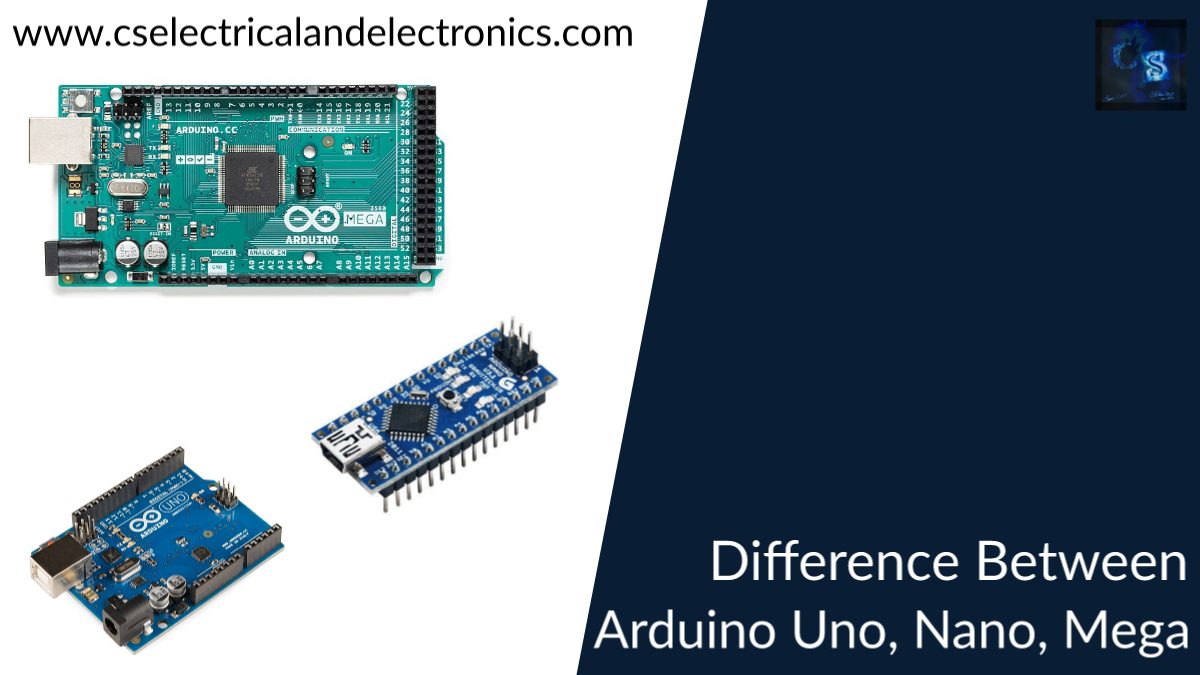Difference Between Arduino Uno, Nano, Mega, Features, Applications
Hello guys, welcome back to my blog. In this article, I will discuss the difference between Arduino Uno, Nano, and Mega, the features of Arduino Uno, Arduino Nano, Arduino Mega, and the applications of Arduino Uno, Nano, Mega.
If you have any electrical, electronics, and computer science doubts, then ask questions. You can also catch me on Instagram – CS Electrical & Electronics.
Also, read:
- Electronic Components Procurement, Top Steps To Follow Procurement
- What Is A AIrbag In The Car, How It Will Work, Benefits Of Using
- Difference Between Device Driver And Application Programming
Difference Between Arduino Uno, Nano, Mega
Arduino Uno Board
Arduino board includes 14 digital I/O pins, 6 analog inputs, a power jack, ceramic resonator-A16 MHz, USB connection, RST button, and ICSP header, these all support the microcontroller for further operation by connecting the board to the computer. You can give a power supply to this board through an AC/DC adapter, USB cable, or battery.
Features Of Arduino Uno
- The operating voltage of the Arduino Uno is 5V.
- The input voltage for Arduino Uno ranges from 6V to 20V.
- Arduino Uno has 14 input-output pins.
- Having 6 analog inputs.
- Each I/O pin has a 40 mA DC current.
- For a 3.3v pin, the DC current is 50mA.
- It has 32kb flash memory.
- It has a 2 kb SRAM.
- It has a 1kb EEPROM.
- The clock speed is 16MHz.
Applications of Arduino Uno
- Can be used in Designing basic circuit designs.
- It is used in the development of an automation system.
- It can be also used in developing projects based on code-based control.
- This Arduino Uno is used in do-it-yourself project prototyping.
Arduino Nano Board
It is also a type of microcontroller board that will be designed by Arduino.cc. This is a small-sized board and flexible with a wide variety of applications.
Features of Arduino Nano
- The operating voltage of the Arduino nano is 5v.
- The input voltage for Arduino nano varies from 7volt to 12 Volts.
- It has a total of 22 input-output pins.
- It has six input pins named from A0 to A5 and it’s having 14 digital pins.
- An Arduino nano consumes a 19mA current.
- Each input-output pin has a 40 mA DC current.
- It has 32kb flash memory, 2kb SRAM, and 1kb EEPROM.
- The clock’s speed of Arduino nano is 16MHz.
Applications of Arduino Nano
- This can be used in embedded systems.
- You can use Arduino nano in automation.
- This can be used in robotics.
- Used in control systems, and instrumentation.
Arduino Mega Board
The Arduino Mega is also a microcontroller board, which is based on the Atmega2560. It is having 54 digital input-output pins, of which 15 pins can be used as PWM output. It also has 16 analog inputs, 4 UARTs, a 16mHz crystal oscillator, a USB connection, a power jack, an ICSP header, and a reset button. To activate this board just connect it to a computer through USB and power it with AC to DC adapter.
Features of Arduino mega
- The operating voltage for the Arduino mega board is 5 volts.
- The input voltage varies from 6 volts to 20 volts.
- It has 54 digital input-output pins. ( 15 pins can be used as PWM output.)
- It is having 16 analog inputs.
- Each pin has a 20mA DC current.
- The 3.3v pin has a 50mA DC current.
- It has 256kb flash memory.
- It has 8kb SRAM, 4kb EEPROM, and 16MHz clock speed.
Application of Arduino mega
- This is used in the development of 3D printer
- Used to control and to handle more than one motor.
- Used in sensing and in the detection of temperature.
- This can be used in IoT applications.
I hope this article may help you all a lot. Thank you for reading. If you have any doubts related to this article “difference between Arduino Uno, Nano, Mega” then comment below.
Also, read:
- 100 + Electrical Engineering Projects For Students, Engineers
- 1000+ Automotive Interview Questions With Answers
- 1000+ Electronics Projects For Engineers, Diploma, MTech Students
- 1000+ MATLAB Simulink Projects For MTech, Engineering Students
- 50 Advanced Level Interview Questions On CAPL Scripting
- 500+ Embedded System Projects For Engineer, Diploma, MTech, PhD
- 500+ Projects For Diploma Electrical, Electronics Student, Diploma Project
- 8051 Microcontroller Timers, TCON Register, TMOD Register

